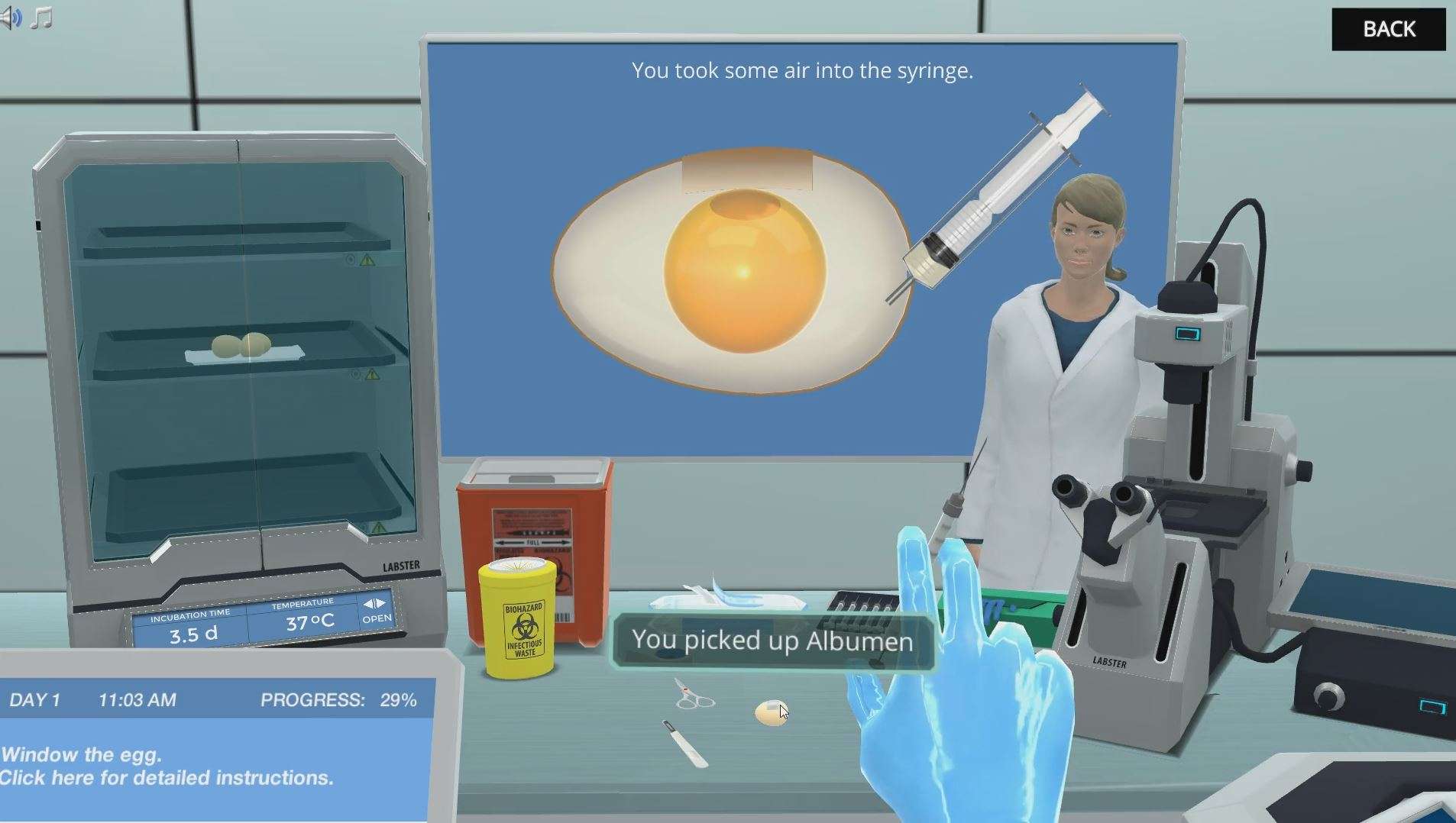Heading 1
Heading 2
Heading 3
Heading 4
Heading 5
Heading 6
Lorem ipsum dolor sit amet, consectetur adipiscing elit, sed do eiusmod tempor incididunt ut labore et dolore magna aliqua. Ut enim ad minim veniam, quis nostrud exercitation ullamco laboris nisi ut aliquip ex ea commodo consequat. Duis aute irure dolor in reprehenderit in voluptate velit esse cillum dolore eu fugiat nulla pariatur.
Block quote
Ordered list
- Item 1
- Item 2
- Item 3
Unordered list
- Item A
- Item B
- Item C
Bold text
Emphasis
Superscript
Subscript
About This Simulation
Dissect chicken and mouse embryos to visualize and analyze embryonic development. Compare genetic results from the model organisms with the genetic laboratory results from a human case study to determine the cause and effect of Liebenberg Syndrome.
Learning Objectives
- Window a chicken egg
- Dissect a limb bud
- Identify different Hamilton-Hamburger stages of chick development
- Analyze Next Generation Sequencing data
About This Simulation
Lab Techniques
- Light microscopy
- Next Generation Sequencing
- Limb bud dissection
- Chicken egg windowing
Related Standards
- HS-LS4-1
- Topic 6.8: Biotechnology
- Biology Unit 3: Genetics
Learn More About This Simulation
What determines whether a body grows an arm or a leg?
In the Embryology simulation, you will learn how to window a chicken egg and decipher the Hamburger-Hamilton stages of chick embryonic development using a light microscope. Supplement your observations with Next Generation Sequencing of mice embryos to pinpoint the genes involved in limb development.
Investigate a family’s genetic condition
In this simulation, you will first uncover the basis of a patient’s inherited genetic condition. Begin by identifying common and specific genes involved in hindlimb and forelimb development using Next Generation Sequencing of mouse limb bud RNA. You will then make an educated hypothesis about which gene is mutated in Liebenberg Syndrome based on the phenotype.
Experiment with Embryonic Development
To understand and analyze the different stages of embryonic development, you will learn how to incubate chicken eggs and window them at different times to observe morphological changes. Observe the various stages of embryonic development by using a light microscope, and view and compare larger-than-life 3D models of chick embryos at different Hamburger-Hamilton stages of development.
Next, compare the morphological and genetic similarities between model organisms and human embryonic development: what are the evolutionary reasons for similarities between embryonic development in animals? To better understand these similarities, you will perform a mouse limb bud dissection in preparation for measuring the gene expression levels in different tissues throughout development. Analyze multiple types of Next Generation Sequencing data output to hypothesize the impact of over- or under-expression of different genes involved in limb development.
Compare Genetic Expression Levels
Use Next-Generation Sequencing to determine RNA expression levels of healthy subjects and predict the effects of incorrect gene expression levels on limb development. Will you be able to figure out which genetic mutations affect limb development in Liebenberg Syndrome?
For Science Programs Providing a Learning Advantage
Boost STEM Pass Rates
Boost Learning with Fun
75% of students show high engagement and improved grades with Labster
Discover Simulations That Match Your Syllabus
Easily bolster your learning objectives with relevant, interactive content
Place Students in the Shoes of Real Scientists
Practice a lab procedure or visualize theory through narrative-driven scenarios


FAQs
Find answers to frequently asked questions.
Heading 1
Heading 2
Heading 3
Heading 4
Heading 5
Heading 6
Lorem ipsum dolor sit amet, consectetur adipiscing elit, sed do eiusmod tempor incididunt ut labore et dolore magna aliqua. Ut enim ad minim veniam, quis nostrud exercitation ullamco laboris nisi ut aliquip ex ea commodo consequat. Duis aute irure dolor in reprehenderit in voluptate velit esse cillum dolore eu fugiat nulla pariatur.
Block quote
Ordered list
- Item 1
- Item 2
- Item 3
Unordered list
- Item A
- Item B
- Item C
Bold text
Emphasis
Superscript
Subscript
A Labster virtual lab is an interactive, multimedia assignment that students access right from their computers. Many Labster virtual labs prepare students for success in college by introducing foundational knowledge using multimedia visualizations that make it easier to understand complex concepts. Other Labster virtual labs prepare learners for careers in STEM labs by giving them realistic practice on lab techniques and procedures.
Labster’s virtual lab simulations are created by scientists and designed to maximize engagement and interactivity. Unlike watching a video or reading a textbook, Labster virtual labs are interactive. To make progress, students must think critically and solve a real-world problem. We believe that learning by doing makes STEM stick.
Yes, Labster is compatible with all major LMS (Learning Management Systems) including Blackboard, Canvas, D2L, Moodle, and many others. Students can access Labster like any other assignment. If your institution does not choose an LMS integration, students will log into Labster’s Course Manager once they have an account created. Your institution will decide which is the best access method.
Labster is available for purchase by instructors, faculty, and administrators at education institutions. Purchasing our starter package, Labster Explorer, can be done using a credit card if you are located in the USA, Canada, or Mexico. If you are outside of North America or are choosing a higher plan, please speak with a Labster sales representative. Compare plans.
Labster supports a wide range of STEM courses at the high school, college, and university level across fields in biology, chemistry, physics, and health sciences. You can identify topics for your courses by searching our Content Catalog.















